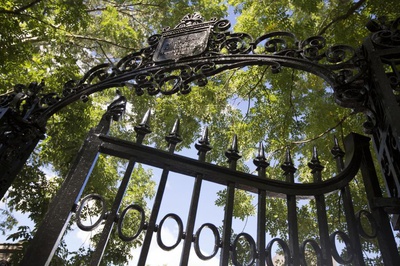
News
Nearly 200 Harvard Affiliates Rally on Widener Steps To Protest Arrest of Columbia Student

News
CPS Will Increase Staffing At Schools Receiving Kennedy-Longfellow Students

News
‘Feels Like Christmas’: Freshmen Revel in Annual Housing Day Festivities

News
Susan Wolf Delivers 2025 Mala Soloman Kamm Lecture in Ethics

News
Harvard Law School Students Pass Referendum Urging University To Divest From Israel
HBC Prepares for 'Departure'
Harvard Ballet's latest show investigates modern and contemporary movement
From classical ballet to ballroom dancing, the Harvard Ballet Company’s “Pointes of Departure” demonstrates its versatility. The aptly titled show—which starts today and will run through Sunday, November 23—showcases the work of student, alumni, and professional choreographers, using classical ballet as a point of departure into the world of modern and contemporary movement.
Larissa D. Koch ’08-’09 and Matthew L. Mendez ’09 worked to create the first piece by a student choreographer and student composer to premiere on the stage of the New College Theatre. The partnership has been a unique opportunity for collaboration across artistic disciplines.
“One thing that I regretted at Harvard was that the music people are sort of over here and then over there are the literary, visual people and they don’t interact that much,” says Mendez, who began working on his composition over the summer. “It makes me happy that I’m getting to collaborate outside of the musical world.”
Koch and Mendez’s “Rêves/Cauchemars” explores the interaction between the musicians and the dancers. “I find watching musicians’ play to be very interesting movement,” Koch says. “I was interested in blurring the lines between where the music starts and where the dance starts.” To highlight the interplay between them, Koch broke with tradition and put the musicians on stage with the dancers instead of out of view in the pit. She intentionally tailored costumes and movements so that at the beginning of her piece it is difficult to tell who is a dancer and who is a musician.
“What I think that the art needs to move forward is exactly a collaboration of that type,” says Lauren E. M. Chin ’08-09, a dancer in the piece. However, Chin also notes the technical difficulties inherent in coordinating so many bodies on one stage. “It demands a lot more of the dancers,” she says, “and I’m sure that we were very distracting to the orchestra members.”
Alumni choreographer Claudia F. Schreier ’08 faced a different type of challenge in arranging her work for the production; she had to map out most of the steps in New York, where she now lives, while her dancers were in Boston. This meant that instead of being able to use the dancers to help her fully visualize the piece, Schreier had to use her imagination.
“I set out step-for-step from the beginning to the end of the music,” she says. “It was almost as though I were writing a paper, which was an extremely unorthodox way of choreographing.”
In “Appalachian Spring”—the iconic work about the American frontier created by choreographer Martha Graham and composer Aaron Copland—dancers were charged with living up to the standards of performance upheld by the Martha Graham Foundation. As part of their licensing agreements, the Foundation sends someone to set the piece in order, ensuring that Graham’s choreography is properly preserved.
“As a piece of Graham’s work, it’s a challenge for the dancer to embody the movement as she saw it,” says Chin, who dances the shared role of the bride in “Appalachian Spring.”
Since it is a piece of theatrical ballet, as opposed to the more abstract work of Koch and Schreier, the dancers must also relate a narrative in their performances. “At every moment I have to think about what the bride is thinking now,” says Chin. “It’s such a beautiful story, I want to make sure I’m doing it honestly and not superficially.”
“Pointes of Departure” also features a work by Susan Shields and the classical piece “Le Corsaire,” as well as guest appearances by Harvard Ballroom and the Harvard College Irish Dancers. Composed of diverse dances, the production builds upon the Harvard Ballet Company’s 2006 “American Grace,” which featured the work of choreographers from George Balanchine to Bob Fosse to Fred Astaire.
Like “American Grace,” “Pointes of Departure” demonstrates and relies on the diversity and strength of Harvard’s dancers, choreographers, and composers. As Koch says, “Suddenly you get to tech week and it seems awful, but by the end of the week it’s really great. One of the advantages of working with talented people is that it comes together.”
Want to keep up with breaking news? Subscribe to our email newsletter.
From Our Advertisers

Over 300+ courses at prestigious colleges and universities in the US and UK are at your disposal.

With innovative financial tools combined with financial education, Collegiate empowers students to take control of their finances and build confidence in their money management skills.

Serve as a proctor for Harvard Summer School (HSS) students, either in the Secondary School Program (SSP), General Program (GP), or Pre-College Program.

With an increasingly competitive Law School admissions process, it's important to understand what makes an applicant stand out.

Welcome to your one-stop gifting destination for men and women—it's like your neighborhood holiday shop, but way cooler.

Admit Expert is a premium MBA admissions consulting company, helping candidates secure admission to top B-schools across the globe with significant scholarships.
